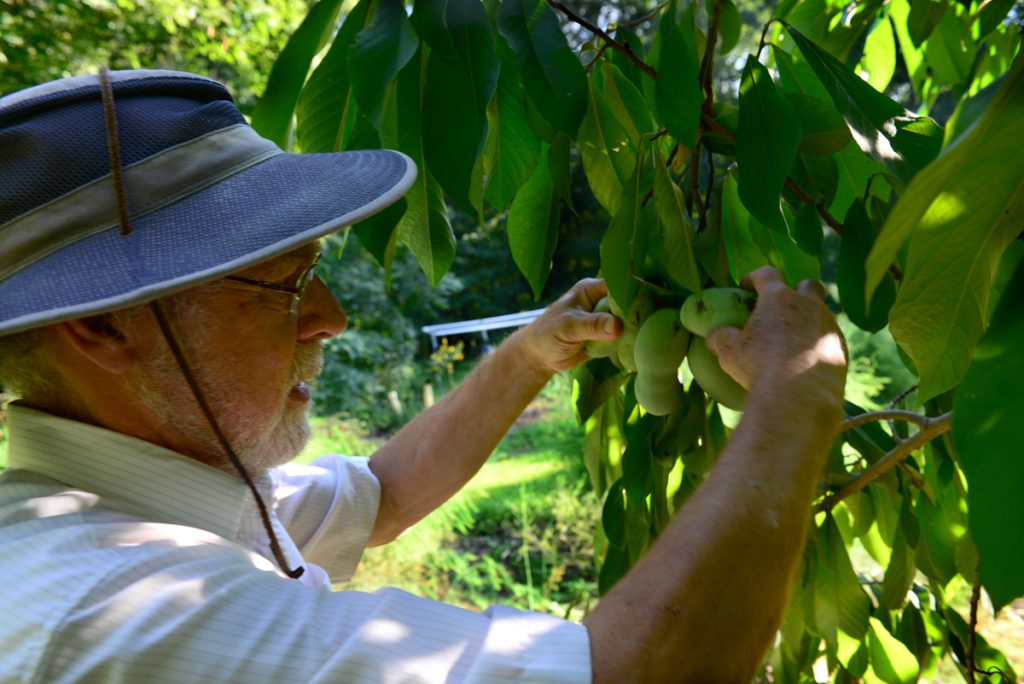From Jack Kertesz via email Dec. 2020:
Ken Asmus recommends seedlings for their colonizing ability. Pretty convincing article.
https://oikostreecrops.com/time-to-prune-stem-density-and-the-life-of-the-pawpaw-colony/
100 3-6″ seedlings are $134. I would be interested in seeing these spread around, or potted and greenhouse grown for a year.
:I have a bunch of potted pawpaws from several different seed sources, New York, Vermont, Oikos….. I just don’t know exactly where I should put them, or in what configuration/spacing, or how much shading they should have for establishing them, and how to provide the shade. One idea I had was to put pole bean teepees around them for a few (how many?) seasons. Maybe the pole beans are in an arc only on the south sides of each one. And then of course, they will need full sun for fruit ripening….. Anyone have thoughts about this?
From NAFEX facebook page:
Scooter Marsh I’ve had a handful of Pawpaw trees for about 15 years, central Michigan, I’ve never had winter damage to trees or buds, but on several occasions have had the trees in full bloom and been hit with below 20* F and ended up with only a half a dozen fruits, a couple years ago I had zero fruit. it seems to be a combo of nasty spring killing the blooms and less than stellar pollinator activity.
Tina Barney Here in east central Vermont near the Connecticut River, I’ve lost Pawpaw blossoms two different years, once from super cold over winter (-28F), and the other from super early warmth that let them break dormancy, then a frost in May hit with the blossoms fully open. Last year I had a nice crop, maybe since they hadn’t spent energy growing fruits the prior year. I hope this year will be another good one, but anything can still happen. We just had 1 foot of wet snow overnight.
Peterson’s Paw Paws Neal Peterson of Harper’s Ferry, WV, nurseryman and pawpaw breeder. Sells only to nurseries and seed and fruit re-sellers. Many original varieties and lots of info about growing and caring for pawpaws. “We are devoted to the pawpaw, to seeing it take its rightful place as one of the fine fruits of the world.”
Pawpaw – A “Tropical” Fruit for Temperate Climates (pdf) by Guy K. Ames excerpted from the January 8, 2018 issue of the Small Farm Quarterly.
Aaron Parker.
Trees should be hardy in most of the state, but only early ripening genetics are likely to ripen and only in decent conditions, with the limiting factor being heat units rather then season length. Hot micro climates can be helpful. Planting seedlings with early ripening genetics seems to be the most successful tactic so far as graft unions often fail in cold winters on young trees. Seedlings of “PA Golden” have a good track record, other likely parents include “Summer Delight” and “VE-21”. If you do decide to plant grafted stock, you may want to either protect the graft union by insulating with a mound of snow (after rodent protection) or plastic insulation like Sill-Seal or try holding plants in pots in a root cellar for their first winter. Young pawpaws can’t handle full sun, but mature trees need sun to ripen a decent crop of fruit, Blue-X grow tubes can be used to shelter young plants, as can large tomato cages covered in row cover, tall perennials or existing trees that can be cut down after a couple years. Shenandoah (excellent flavor, large size) , PA Golden (not sure which PA golden), and Prolific (not great flavor) ripen in zone 5 eastern VT.
 Article in Civil Eats: Climate Change Could Make Pawpaws a Valuable Crop for Northern Farmers
Article in Civil Eats: Climate Change Could Make Pawpaws a Valuable Crop for Northern Farmers

